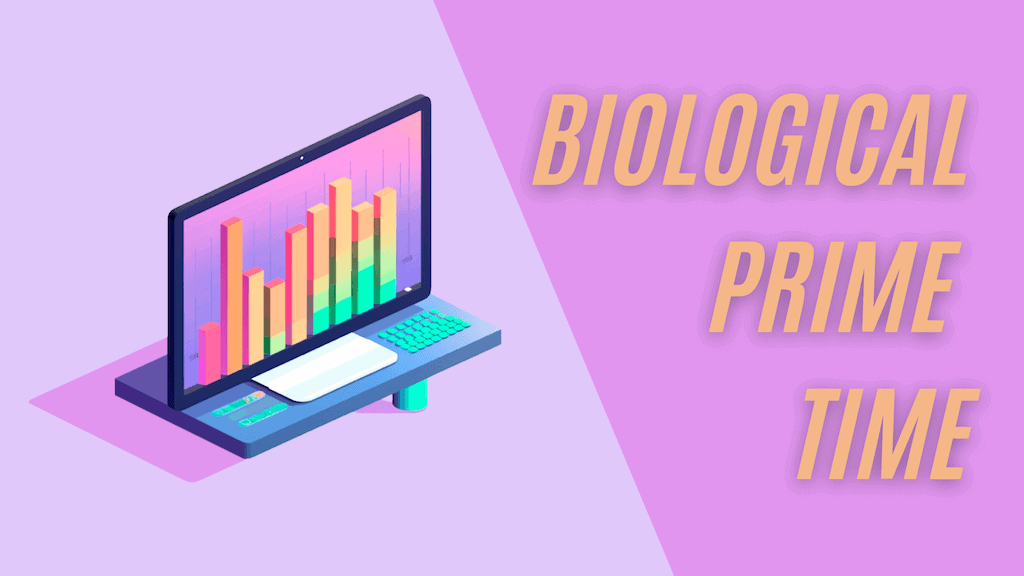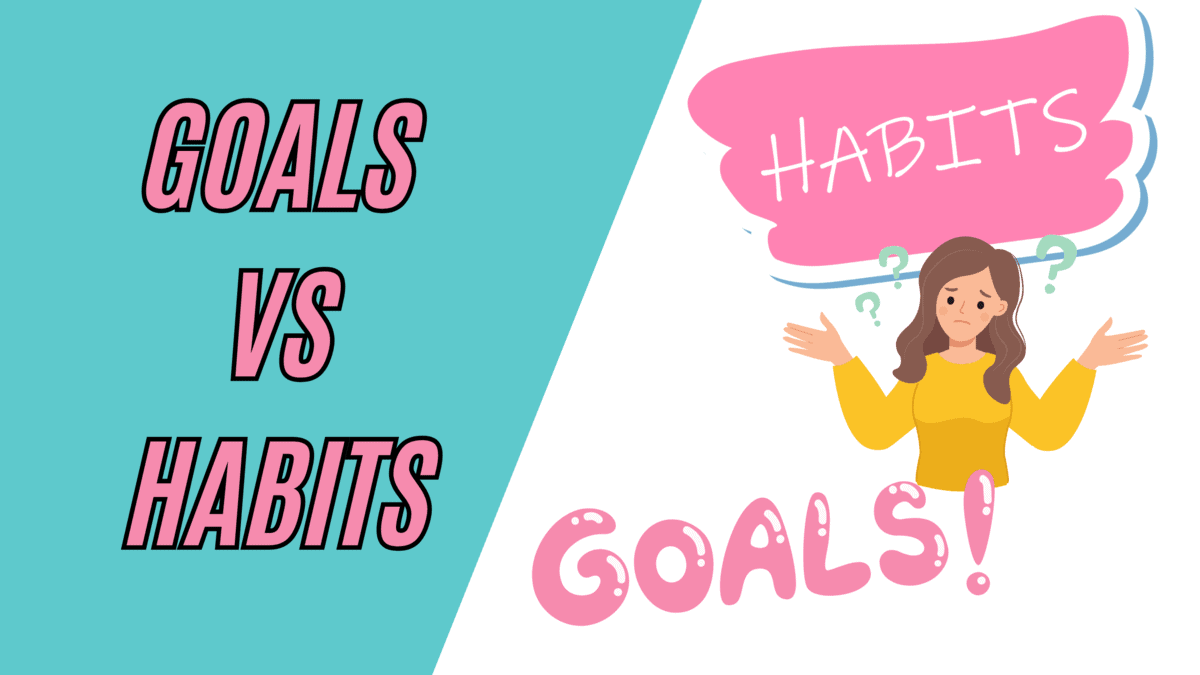In today’s fast-paced world, we all strive to make the most of our days, don’t we?
Being productive is what moves the needle on our goals and leads to a deep sense of satisfaction and accomplishment. What if I told you that the key to unlocking your full potential might lie in understanding your own, unique Biological Prime Time?
Biological Prime Time refers to the period during the day when our energy levels, focus, and productivity are at their peak. It is during these hours that we are most capable of performing tasks that require mental and physical effort.
By identifying and harnessing your Biological Prime Time, you can optimize your schedule to be as productive as possible, setting yourself up for success.
Intrigued? Stay with us as we delve deeper into the concept of Biological Prime Time, how to find your own Biological Prime Time, and the results from our own Biological Prime Time experiment.
What is the Biological Prime Time?
You might be wondering “what exactly is the biological prime time?”
Biological Prime Time is defined as the specific time of day (or multiple times) when a person experiences their highest levels of energy, focus, and mental acuity. These prime periods are unique to each individual and can greatly influence one’s overall productivity.
The concept of Biological Prime Time was first introduced by Sam Carpenter in his book Work the System and later gained popularity through the work of Chris Bailey. Their insights have shed light on the importance of aligning our daily schedules with our natural energy patterns.
“not all hours are created equal”
One critical aspect of Biological Prime Time is its connection to ultradian rhythms. Ultradian rhythms are the natural cycles that occur within a 24-hour period, regulating various physiological processes such as alertness, mood, and energy levels.

By understanding these rhythms, you can identify the periods when you are most capable of handling challenging tasks, thus increasing your overall productivity.
The Biological Prime Time is Different for Everyone
It’s important to note that Biological Prime Time is no one-size-fits-all concept. In fact, the ideal times to get work done can vary significantly from person to person, making it crucial to understand and respect your own unique energy patterns.
Several factors contribute to these individual differences in Biological Prime Time. Your diet, for example, can have a significant impact on your energy levels throughout the day. The food you consume acts as fuel for your body and your energy patterns may be influenced by the type of nutrients you consume.
Caffeine intake also plays a role in determining your Biological Prime Time. For some, a cup of coffee or tea can provide a much-needed energy boost, while for others, it may lead to jitters or an energy crash later in the day. Understanding how your body reacts to caffeine can help you fine-tune your prime time.

Your sleep schedule is another crucial factor in determining your Biological Prime Time. The quality and quantity of sleep you get can directly influence your energy levels and cognitive functioning throughout the day.
Early birds, who naturally wake up early and feel most energetic in the morning, may find their prime time during the first half of the day, while night owls, who tend to stay up late and feel more alert in the evening, may experience their peak productivity during later hours.
For example, I (Connor) can wake up in the morning and start working on a project instantly with a high level of focus. Emma on the other hand, struggles to string together a full sentence before she’s been up for a while and had her morning coffee.
Benefits of Identifying Your Biological Prime Time
Understanding and leveraging your Biological Prime Time can provide a multitude of benefits that can significantly enhance various aspects of your personal and professional life.
Increased productivity: By identifying your Biological Prime Time and aligning your high-leverage tasks with these peak energy periods, and low-leverage tasks for low energy periods you can ensure you’re working at your maximum capacity
Improved motivation: Aligning your prime time with important tasks can boost both intrinsic and extrinsic motivation. When you see visible results from completing tasks in a time-efficient manner during your prime time, it serves as a powerful motivator to continue pursuing your goals.
Additionally, working on meaningful tasks during your most energetic and focused periods can enhance your internal drive to succeed, resulting in a self-perpetuating cycle of motivation and accomplishment.
Struggling to determine which tasks are important and which aren’t? Check out our article on the Eisenhower Matrix for task prioritization
Better self-image: Identifying and utilizing your Biological Prime Time can have a profound impact on your self-image. By overcoming procrastination and consistently completing tasks during your prime time, you can boost your self-esteem and develop a more positive outlook on your capabilities. This increased confidence can further enhance your productivity and motivation, creating a virtuous cycle.
How to Determine Your Biological Prime Time
Enter the three-week experiment.
Determining your Biological Prime Time requires a structured approach and a commitment to self-observation. By following a 3-week experiment, you can gain valuable insights into your unique energy patterns and identify the best times to tackle high-leverage tasks.
Here’s a step-by-step guide to help you determine your Biological Prime Time:
Step 1: Set aside 3 weeks – To collect accurate and reliable data, you’ll need to dedicate three weeks to the experiment. During this period, use a spreadsheet platform to track your energy levels, mood, and focus at regular intervals throughout the day. This will help you identify patterns and pinpoint your prime time.
Step 2: Know your tendencies – Are you a night owl or an early bird? Understanding your natural preferences can provide a useful starting point for identifying your Biological Prime Time. This self-awareness can help guide your observations and make the experiment more efficient.
Step 3: Eliminate stimulants and depressants – To obtain accurate results, it’s essential to eliminate substances that can artificially affect your energy levels and mood Things such as caffeine and alcohol. Removing these variables will allow you to observe your natural energy patterns more clearly.
Step 4: Maintain consistent meal times – Eat at the same time every day to ensure that your energy levels are not influenced by irregular eating habits. This consistency will help you better understand how your body’s energy patterns are affected by food intake.
Step 5: Control extraneous variables – To obtain accurate and reliable results, it’s crucial to control any extraneous variables that may influence your energy patterns. Factors such as stress, exercise, and external distractions can all affect your energy levels and focus.
While it may not be possible to eliminate all of these variables, do your best to maintain a consistent routine and environment during the 3-week experiment. This will ensure that your observations are as reliable as possible.
Charting Your Energy Levels

To get the most out of this experiment, you need to make sure you’re charting your energy levels as methodically as possible.
All you need is a spreadsheet to record your energy levels every waking hour for 3 weeks. I know this sounds very dramatic but don’t worry, we’ve made you a spreadsheet to fill out and all you need to do is set a reminder on your phone to go off every hour.
Get your Biological Prime Time experiment spreadsheet HERE.
Now we’ve made the spreadsheet for you but, we cannot set up all of your alarms throughout the day so you’re on your own for that one I’m afraid. This process only took me a few minutes to sort out and it’s not as bad as it looks.
These are the hours we decided to check our energy levels. 8 am through 9 pm.
We usually wake up at 7:30 am every day so the first check-in at 8 am makes sense. We didn’t see much value in tracking our energy levels super late into the night so, 9 pm was our cut-off. Again, this is subjective and dependent on your individual situation.

On day one, use the spreadsheet to start tracking your energy levels when you wake up.
Repeat this process every hour for the next 3 weeks so that you have enough data to start seeing some trends in your energy levels.
To spot these trends, all you need to do is take the average for every hour of the day and plot the final results to see which hours of the day you have more or less energy.
Don’t worry, we’ve worked this into the spreadsheet for you, simply click the ‘results’ tab to see the graph (we’d recommend not looking at the results tab until after the experiment has been completed.)
Analyzing Your Energy Levels to Maximize Peaks
Okay, you’ve done the 3-week experiment and collected all your data. The next step is to analyze the data and identify your Biological Prime Time which can then be used to maximize your productivity. Here’s exactly how you can use your energy level data to optimize your daily schedule:
Identify your Biological Prime Time: First you need to actually determine when you’re at peak performance. Examine the data you’ve collected to pinpoint the periods when your energy, focus, and motivation levels are consistently at their highest. These peaks represent your Biological Prime Time – the optimal period for tackling high-leverage tasks that require your full attention and mental acuity.
Visualize trends: We’ve already done this for you in the spreadsheet but visualizing when you have higher and lower energy levels throughout the day makes it much easier to plan out your daily tasks in the most effective manner.
Schedule high-leverage tasks during peak times: Now you have your Biological Prime Time, you can start to consciously schedule your day with the most important and demanding tasks being completed during your peak hours.
By devoting your high-energy periods exclusively to work that contributes to your success, you can maximize your productivity and move the needle more effectively on those long-term annual, quarterly, and monthly goals.
Schedule your low-energy hours: Making the most of your Biological Prime Time isn’t just about getting high-reward tasks completed during high-energy periods, it’s about making the most out of your low-energy periods too.
This can be achieved by strategically allocating lower-energy tasks like admin or routine chores to low-energy periods of the day, you can maintain productivity throughout the day while ensuring that your most valuable tasks receive the attention and energy they deserve.
My Biological Prime Time Results
Here’s what my biological prime time graph looked like after the 3-week experiment. Evidently, my optimal time for high-focus work is the late morning into the early afternoon.
So, with that, I decided to structure my days such that:
- Early on in the morning for light admin, responding to emails etc.
- Late morning to early afternoon for high-energy client work
- Late afternoon for low-energy business tasks like outreach
Making the most of your energy dips
While it’s essential to maximize the benefits of your Biological Prime Time, it’s equally important to make the most of your energy dips.
By strategically planning your day and incorporating activities that can help recharge your batteries, you can maintain productivity even during periods of lower energy.
Here’s how to effectively navigate your energy dips:
Schedule Recharging Activities
During your energy dips, consider scheduling activities that can help rejuvenate your mind and body. This might include taking short power naps, practicing mindfulness or meditation, or going for a brief walk outdoors.
These breaks can provide a valuable opportunity for rest and recovery, allowing you to return to your tasks with renewed focus and energy.
We like to go for a walk to rejuvenate our energy throughout the day. There’s nothing better than some fresh air, direct sunlight, and a bit of nature to act as a bit of a reset on the day.
Top Tip: If you do take a power nap during the day, we have a rule that if we do ever take a nap during the day, we don’t have one later than 3 pm – which is also backed up by experts.
Perform Low-Energy Tasks
Allocate tasks that require less mental focus and energy during your energy dips. These tasks might include routine chores, administrative work, or other low-priority tasks that don’t demand your full attention.
As mentioned above, I like to schedule low-energy tasks like clearing my inbox using Inbox Zero and business development activities like outreach during these times.
Explore Lasting Energy Boosters
While it’s recommended to avoid artificial stimulants during the 3-week experiment, you can explore natural alternatives to help you ride through your energy dips once you’ve finished.
Green tea, for example, contains a moderate amount of caffeine and a compound called L-theanine, which can provide a gentle, sustained boost in energy and focus without causing jitters or crashes.
Personally, I’m a coffee person through and through so that’s what works for me! A coffee early on in the morning and some Athletic Greens to keep me going through the day.
Be Mindful of Your Diet
Your energy levels can be significantly influenced by the food you consume.
Pay close attention to how your diet may be affecting your energy dips. Opt for nutrient-dense meals and snacks that provide a steady release of energy, such as whole grains, lean proteins, and healthy fats.
Avoiding refined sugars and processed foods can help prevent rapid fluctuations in your energy levels – just think about it, when was the last time you ate a big unhealthy, carb-filled meal and didn’t want to fall asleep straight after?
Understanding and embracing your natural energy patterns, both the peaks and the dips, will enable you to work more efficiently and create a daily routine that supports your overall well-being.
Looking for some more productivity hacks? Check out our favorite time management techniques:
- The Seinfeld Strategy: Unlock the secrets to daily consistency
- The Pareto Principle: Get 80% done with only 20% of the work
- The Kanban Method: Never get hung up on where a project is again
- The Pomodoro Technique: For when you struggle to get started on a task
Biological Prime Time FAQs
Biological Prime Time refers to the periods during the day when a person has the most energy and focus. It affects productivity by helping individuals schedule tasks during their most energetic times, enhancing efficiency and effectiveness.
Identify your unique Biological Prime Time through a three-week experiment that involves tracking your energy, focus, and motivation levels throughout the day, while controlling external factors like diet, caffeine, and sleep.
Factors that can influence a person’s Biological Prime Time include diet, caffeine intake, sleep schedule, and personal preferences for being an early bird or a night owl.
The three-week experiment helps determine one’s prime time by collecting data on energy, focus, and motivation levels while controlling external factors. Analyzing this data allows you to identify patterns and discover your peak energy periods.
Maximize productivity during peak energy periods by tuning out distractions, focusing on high-leverage tasks, finding natural energy boosters, and maintaining a consistent daily routine that aligns with your peak times.
Manage energy dips effectively by scheduling recharging activities like naps and breaks, performing low-energy tasks, and being mindful of your diet and potential energy boosters like green tea.
Benefits of discovering and utilizing your Biological Prime Time include increased productivity, higher motivation, better self-image, and improved work-life balance.




